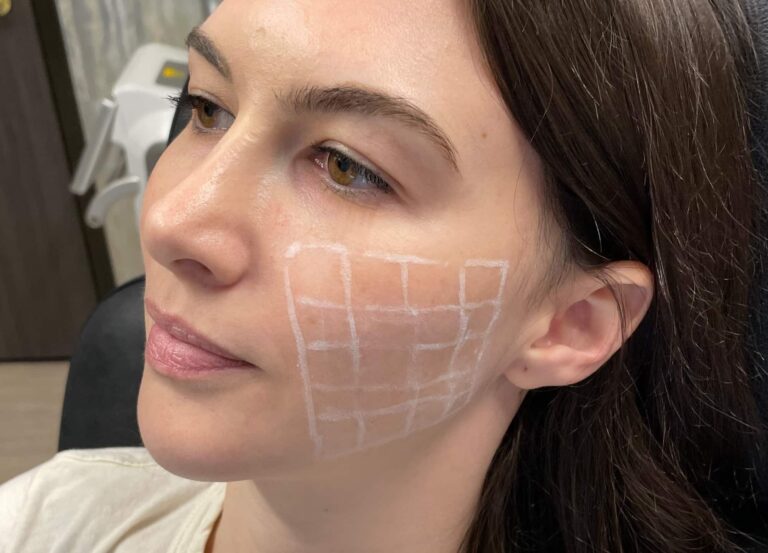A woman’s right to choose is a beautiful thing—unless, of course, it means choosing between beautiful things. Laser or IPL? Kybella or lipo? Radiesse or Restylane? Welcome to This/That, where each month, we’ll compare two common solutions to popular aesthetic concerns, delivering all the pros, cons, and caveats you need to make safe, smart decisions.
Most of us have a physical attribute or two that, given a choice, we’d consider revising—which, for the record, makes us human, not superficial. One common area of insecurity is the nose. The American Society of Plastic Surgeons’ most recent statistics report reveals that rhinoplasty, or nose reshaping, is the third most popular cosmetic plastic surgery procedure in the United States. In recent years though, another nose-tweaking technique has surged in popularity: the so-called liquid nose job.
Given 20 minutes and one syringe of filler—zero anesthesia, operating tools, splints, or stitches—an injector can temporarily alter the shape of your nose. No, a filler rhino can’t actually make the nose smaller, but it can improve symmetry and shift proportions, allowing the nose to read as smaller or simply less noticeable. “The idea is to make the nose as smooth as possible, to camouflage harsh light and shadows and essentially make the nose boring, as I like to say, so it ends up looking smaller in the end,” explains Dr. Dara Liotta, a board-certified facial plastic surgeon in New York City.
Still, despite what some social media posts imply, it’s not for everyone. In certain circumstances, the addition of filler can actually amplify the issue you may be trying to camouflage. So which type of nose job is best for treating various cosmetic and functional nasal issues?
“I have patients come in all the time, talking about both options. They say, ‘I’m not sure if I’m a candidate for one more than the other,’” says Dr. Liotta. “I see this, literally, 10 times a day.”
During my own nose-altering journey, I ultimately opted to go the surgical route after learning, via multiple consultations, that a nonsurgical rhinoplasty would actually maximize the very features (nasal tip and dorsal hump) that I was hoping to minimize. That said, nonsurgical nose jobs can be an ideal option for many people, for many different reasons. We asked a panel of experts which issues could best be remedied by each procedure.
What distinguishes a surgical rhinoplasty from a liquid nose job?
The classic rhinoplasty
First, there’s the obvious: The former is a “surgical procedure that involves anesthesia and recovery time,” explains Dr. Adam Kolker, a board-certified plastic surgeon in New York City. A rhinoplasty permanently changes the size and shape of the nose. A plastic surgeon can shave down a dorsal hump, narrow or rotate the tip of the nose, shorten the length, adjust crooked anatomy, and even correct breathing issues caused by a deviated septum (that’s the cartilage wall dividing the inside of the nose). In short, “all aspect[s] of cosmetic and functional nasal surgery are corrected by a true rhinoplasty,” explains Dr. Rod Rohrich, a board-certified plastic surgeon in Dallas.
Depending on the issues you’re aiming to fix and your plastic surgeon’s preferences, the procedure can be performed in either open or closed fashion. In an open rhinoplasty, a small incision is made in the columella, or strip of tissue between the nostrils. During a closed procedure, your surgeon works through the nostrils to make modifications so that no external incisions (or subsequent stitches) are necessary.
Regardless of the approach taken, most surgical rhinoplasties are performed on an outpatient basis, under general anesthesia—meaning you’ll be in a sleeplike state throughout the surgery (which typically lasts a few hours).
Recovery time is an important variable to consider when weighing scalpel versus syringe. Even though post-surgery discomfort tends to be tolerable, surgeons commonly prescribe painkillers (personally, all I needed was to take OTC Tylenol for one day). Swelling and bruising can be considerable and last up to a few weeks. You’ll wear a splint for about a week, and if you had an open procedure, you’ll need to have the stitches removed around day 10.
Related: 8 Rhinoplasty Recovery Rules You Should Always Follow After Surgery
While risks such as bleeding, infection, and airway changes are possible, oftentimes breathing actually improves following rhinoplasty, Dr. Kolker explains, since standard surgical maneuvers “open up the internal valves of the nose, improving air flow.” Many cosmetic changes in the nose are visible almost immediately, but it can take several months for swelling to subside and up to a year for results to fully mature.
As with all cosmetic procedures, the cost of surgical rhinoplasty varies greatly depending on the complexity of the operation, your surgeon’s expertise, and where he or she is located. On average, RealSelf members report the cost of a surgical nose job to be around $7,500, including fees for the surgeon, anesthesia, and post-op care; however, some doctors charge upwards of $25,000 for the procedure. Another monetary downside: cosmetic rhinoplasty is not covered by medical insurance, though if the procedure involves a medically necessary component, such as septoplasty, insurance may provide partial coverage.
To recap, a surgical rhinoplasty can permanently correct any type of nasal issue you’re aiming to fix. Although pricey, it’s intended to be a one-and-done procedure. Such permanence can be a con for some, however: What happens if you don’t like the final results? This is part of the reason rhinoplasty has the highest revision rate in all of plastic surgery—and also why it’s important to choose your surgeon wisely and have a thorough discussion about goals and risks.
“The nose is a difficult place to operate—it’s best left to surgeons who work on it all the time,” Dr. Liotta explains. “So really, the question you want to ask your surgeon, in order to get the best possible result, is how often do you perform rhinoplasties?”
Ideally, Dr. Liotta says you would want to find a surgeon who performs at least four to five rhinoplasties per month, at a very minimum. “I, for example, do anywhere between one and 10 rhinoplasties every single week,” Liotta says.
The nonsurgical or liquid nose job
Commonly dubbed the liquid nose job, this no-downtime procedure involves the injection of microdroplets of hyaluronic acid (HA) filler into the nose, usually placed deep along the bridge and sometimes into the tip. Unlike surgical rhino, in which bone and cartilage can be removed to level a hump or reduce specific features, a nonsurgical rhinoplasty is purely additive.
“Since we are obviously adding volume, there are only certain places or issues that injection rhino is good for,” Dr. Liotta explains. “It’s great if you have a bump on your nose that’s not too big, for instance—we’ll put a little filler above the bump, a little bit below, and make it look straight on the profile.”
Overall, nonsurgical rhinoplasty involves adding filler to camouflage imperfections, says Dr. Steven Pearlman, a board-certified facial plastic surgeon in New York City. The goal is to achieve greater symmetry by smoothing a dorsal hump or refining a slightly droopy or bulbous tip. What liquid rhino cannot do is correct underlying structural deformities or breathing issues or physically shrink the nose.
“A nonsurgical rhinoplasty is ideal for somebody… who is an aesthetic perfectionist and desires a subtle improvement to the nose,” says Dr. Lara Devgan, a board-certified plastic surgeon in New York City and RealSelf’s chief medical editor.
If you are looking to change the size or shape of the tip of the nose (rather than its mere droopiness) or adjust the width of your nose, a nonsurgical rhinoplasty will not achieve either goal, Dr. Liotta says. Additionally, in cases wherein the dorsal hump is too large, “filler is not going to be good, even to straighten the profile, because I’d have to make it look as if your nose is coming off of your forehead to give it a straight appearance,” she adds.
In terms of nose-appropriate fillers, doctors favor the thickest HA gels—those that are technically of high viscosity, high density, and high cohesivity—because “we want what we’re injecting to look like natural bone and cartilage,” Dr. Liotta says. Juvéderm Voluma and Restylane Lyft are the most popular choices among the experts we polled. In some cases, a shot of Botox may also be injected into the depressor muscle at the base of the nose, to help elevate a hanging tip.
Some doctors charge per syringe, while others charge a flat fee for the procedure. According to RealSelf members, the average cost of a nonsurgical nose job is $1,050. That might seem like a steal compared to surgery—especially since filler placed in the relatively immobile nose can last up to two years—bear in mind, however, that liquid rhinoplasties have to be repeated on an ongoing basis in order to maintain results.
And while it’s typically a quick, painless procedure, nonsurgical rhinoplasties aren’t without risk. “In the danger triangle of the face where the nose is located, that central triangle, we are very concerned about risks of vascular occlusion, which can cause tissue necrosis or even a remote risk of permanent blindness,” notes Dr. Devgan.
This area of the face is considered high-risk for injections because “the blood supply around the nose is very rich,” Dr. Kolker explains. The biggest risk, then, is intravascular injection, or accidentally injecting filler into a blood vessel. Should this happen, the tissues that the occluded artery normally nourish are deprived of oxygen and nutrients and can eventually die. When the skin is affected, this complication is called tissue necrosis. When the vessels feeding the eye become blocked, sudden and irreversible blindness can occur. “There have been many reports of blindness in the literature but very rare [reports] of someone regaining sight after [going] blind from filler,” notes Dr. Pearlman. Assuming temporary HA fillers were used, skin can usually be saved with a timely and generous injection of hyaluronidase, an enzyme that dissolves HA.
It’s crucial to see a board-certified dermatologist or plastic surgeon—preferably a rhinoplasty specialist—for this procedure. Not only do they possess the intricate anatomical knowledge necessary for successful injection, but they should also have sufficient hyaluronidase on hand to immediately course-correct if something goes wrong.
Can filler serve as a sort of “test run” before rhinoplasty surgery?
Perhaps you’ve wondered whether having a liquid rhinoplasty is a wise way to dip a toe in the rhinoplasty pool. “The problem with that [thinking] is that even though [filler breaks down over time] and we can dissolve it with hyaluronidase, it never really goes away a hundred percent,” says Dr. Liotta. There’s no way to guarantee that a shot or two of the enzyme can melt every trace—and lingering HA can “definitely make surgery a little bit more challenging.”
For any patients who have a history of nasal filler, Dr. Liotta requires them to come into the office for a hyaluronidase injection at least two weeks before the scheduled surgery. Dr. Pearlman prefers to dissolve preexisting filler in two different visits prior to scheduled surgery.
“You should always have your surgical plans set before you step into the operating room—especially with primary rhinoplasty,” Dr. Pearlman adds. Finding leftover filler “is not going to compromise the results of surgery,” but it adds an unknown into the equation, which is not ideal.
The bottom line: Which type of rhinoplasty is right for you?
The answer all depends on which issues—cosmetic, functional, or a combination of the two—you’re looking to correct. Ultimately, in order to make the most informed decision, you need to have a frank discussion with a board-certified provider you trust.
To deliver a successful nasal reshaping, whether surgical or liquid, a plastic surgeon or facial plastic surgeon needs to fully understand “the patient’s anatomy, goals, and desires,” Dr. Liotta says. And you, the patient, need to grasp a few points too—primarily, that each procedure comes with its own set of risks and rewards. Prioritize what matters most to you—be it permanence or reversibility, structural change or cosmetic camouflage—and choose a surgeon with the experience to manage complications and achieve an aesthetic you admire.











